Steam Ubuntu
Introduction to Steam
Steam is a service of video game digital distribution by Valve. The service was released as a software client as a way for Valve for providing automatic updates for the games and expanded for including games from many publishers of the third party. Also, steam has expanded into a mobile digital, web-based, and online storefront.
Steam provides DRM (digital rights management), social networking services, video streaming, and server hosting. Also, it offers the user with automatic updating and installation of games and community aspects like friend groups and lists, in-game chat and voice functionality, and cloud storage.
The software offers a freely available API (application programming interface) which is known as Steamworks, which many developers can apply for integrating many of the functions of Steam into their products such as microtransactions, support for user-made content, and in-game achievements from Steam Workshop.
- Thus, initially integrated for use on Microsoft Windows OSes, versions for Linux and macOS were later published.
- Also, mobile apps were published for Windows, Android, and iOS Phones in the 2010s.
- Also, the platform provides a small selection of content such as films, anime, game soundtracks, design hardware, and software.
- In 2013, the platform of Steam is the largest digital distribution for PC gaming, holding approx 75% of the market share.
- By 2017, users buying games from Steam roughly totaled 4.3 US billion dollars, at least representing 18% of PC game sales globally.
- The service had 34,000+ games with 95 million+ active users monthly by 2019.
- The Steam success has led to the integration of the Steam Machine Microconsoles line which includes the Steam Controllers and SteamOS operating system, Steam Link devices for the Steam Deck, and local game streaming, a handheld PC system tailored to run Steam games.
Service functionality and features
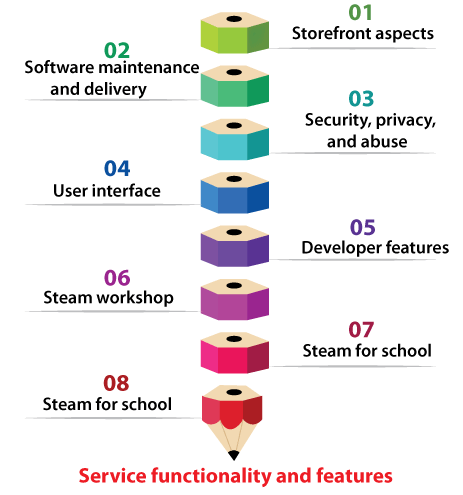
Software maintenance and delivery
The primary service of Steam is to permit its users for downloading games and other applications that they have in the libraries of their virtual software to their local computers as GCFs (Game Cache Files). In May 2008, Valve was initially needed to be the publisher for the games from they had remaining access to the engine and database of Steam, but with the SDK (Steamworks Software Development Kit) introduction, anyone could release to Steam without the direct involvement of Valve.
Valve supports Steam Cloud. It is a service that can store related custom files and saved games on the servers of Valve in September 2008. Users can use this data using any machine executing the Steam client. The games should use the correct aspects of Steamworks for Steam Cloud to implement. Also, users can disable this aspect on a per-account and per-game basis.
Storefront aspects
The Steam client includes a digital storefront which is known as Steam Store from which users can buy computer games. A software license is attached to the Steam account of the user permanently once the game is purchased, permitting them for downloading the software on a compatible device. The licenses of the game could be offered to other accounts in certain situations. The content is transferred using the server’s international network with an appropriate file transfer protocol.
Users of Storefront of Steam can also buy games and other applications as a gift to be offered to other users of Steam. Users could buy these gifts to be kept in the inventory of their profile until they decided to gift them before May 2017.
Also, the Steam store enables users for redeeming the product keys of the store to include applications from the library. These keys can be sold by the providers of the third party like Humble Bundle, shared as a physical release part for redeeming the game, or provided to any user as the promotion part, often used for delivering Kickstarter and other rewards of crowdfunding.
Security, privacy, and abuse
In November 2011, an attempt appeared when Valve closed the forums of community temporarily, citing hacking risks to the service. Valve days later reported the hack had accommodated one of its user databases, potentially permitting the perpetrators for accessing user information, including credit card and encrypted password details.
An error in the software permitted anyone for resetting the password to an account by using the function, i.e., “forgot password” of the client in July 2015. High-profile professional steamers and gamers lost access to their accounts. The content delivery network of Steam was misconfigured to a DDoS attack, leading to cached store pages including personal information being exposed for 34,000 users in December 2015.
Valve added some privacy settings for several steam users, who can set when the status of their current activity is private, disposable to only friends or public in April 2018. In inclusion to being able for hiding their inventory, game lists, and other profile components in the same manner. While these modifications brought the privacy settings of Steam inline with many approaches used by some game console services. Also, it impacted many third-party services like Steam Spy which depended on the public data for estimating Steam sales count.
User interface
Steam has permitted users to analyze their purchased games and construct them into categories fixed by the user and add to the favorite lists for fast access since November 2013. Many players can add various non-Steam games into their libraries, permitting the game to be easily used by the Steam client and offering support that is possible for Steam Overlay aspects. The Steam interface permits for user-defined shortcuts to be included.
A Steam points storefront and system were added in 2020 June, which mirrored the same temporary points systems that had been applied in prior sales over the storefront. On Steam, users can earn points from purchases or by getting community recognition for useful discussion comments or reviews. These points don’t expire because they had within the prior sales, and could be redeemed in an isolated storefront for many cosmetics that are used to the chat interface and profile of the user.
Developer features
Valve offers developers the ability for creating storefront pages for many games to help produce interest in their game ahead of publication. Also, it is essential for fixing a release date that implements into the “build review” of Valve, a free service implemented by Valve to ensure the game could be installed and executed, and other inspects to ensure the launch of the game is trouble-free otherwise.
Valve provides Steamworks an API (application programming interface) that offers development and releasing tools for taking advantage of the features of the Steam client, free of charge to software developers and games. Steamworks offers player authentication and networking tools for both peer-to-peer multiplayer and server games, matchmaking services, support Steam community groups and friends, Steam achievements and statistics, Steam Cloud support, and integrated voice communications, permitting games to develop with the Steam client.
Steam workshop
It is an account-based hosting service of Steam for video game user-made content. Relying on the title, gameplay modifications, art assets, new levels, and other content might be released to or installed through the Steam workshop from an online account-based and automated process. Originally, the workshop was used for new item distribution for Team Fortress 2. Then, it was recreated for extending support for a game in 2012 including changes for The Elder Scrolls V: Skyrim.
Valve themselves had offered a few user-developed Workshop content as a paid-for aspect in Valve-developed games by January 2015, including Dota 2 and Team Fortress 2 with 57 million+ dollars being paid to content makers with the help of the workshop.
Steam for school
It was a function-limited release of the Steam client that was present free for use in many schools. It was a part of the initiative of Valve for supporting gamification of learning. It was published alongside free Portal 2 versions and a standalone program known as “Puzzle Maker” that permitted students and teachers for creating and manipulating levels. It provided extra authentication security that permitted teachers to distribute and share content by a Steam Workshop-type interface.
SteamVR
It is a virtual reality software and hardware platform integrated by Valve along with a focus on permitting “room-scale” experiences with the help of the base stations for positional tracking, as opposed to those needing the player to stay inside a singular location. In 2014, SteamVR was first defined for the Oculus Rift headset and later extended to support many virtual reality headsets like Valve Index and HTC Vive. Though published for support on Linux, macOS, and Windows. In May 2020, Valve dropped the support of macOS for SteamVR.
Steam Platforms
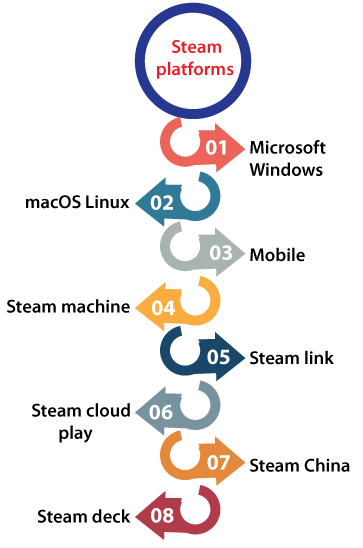
Microsoft Windows
In 2003, Steam exclusively published for Microsoft Windows but has since been shifted to other platforms. Recent client versions of Steam apply the Chromium Embedded Framework.
macOS
Valve releases a client for a Microsoft Windows version, i.e., Mac OS X on 8 March 2010. The disclosure was preceded by a modification in the beta client of Steam for supporting the cross-platform web browser, i.e., WebKit rendering engine rather than the Internet Explorer Trident engine.
Linux
In July 2012, Valve announced that it was integrating a client of Steam for Linux and changing the source engine to natively work on Linux, on the basis of Ubuntu distribution. Valve released a Proton beta version in August 2018, a Windows-compatible and open-source layer for Linux, so that the users of Linux could directly execute Windows games for Linux from Steam.
Other Platforms
Mobile
In later January 2012, Valve published an official client of Steam for Android and iOS devices, following a precise beta period.
Steam Machine
Valve released SteamOS in September 2013. It is a Linux-based custom OS that they had expanded especially aimed to run games and Steam, and the final approach of the Steam Machine hardware.
Steam Link
It was a set-top box that discarded the requirement for HDMI cables to display the screen of a PC and permitted for wireless connection while connecting to any TV. In 2018, that was discontinued, but “Steam Link” now refers to a Remote Play mobile app that permits users for streaming content like games using a PC to Mobile device on a network.
Steam Cloud Play
In May 2020, Valve added support of beta for Steam Cloud Play for developers to permit users to enjoy games in the library which publishers and developers have opted to permit within a cloud gaming service.
Steam China
China has severe regulations on Internet use and video games. However, Steam access is permitted through the governmental firewalls of China. A large section of Steam users is currently from China.
Steam Deck
Valve disclosed the Steam Deck in July 2021. It is a handheld gaming system along with plans for shipping in December 2021. The Deck is established for the Steam games play but could be placed into an isolated dock. The Deck was released on 25 February 2022.
Installing Steam in Ubuntu
Linux has got a lot of interest from gamers because Valve announced its Steam version for Linux Since 2013. A cross-platform and famous engine for gaming, Steam offers various popular and enjoyable games for Linux. We can play our favorite games, interact, and meet with new games using Steam.
In this article, we will explain how we can install Steam in Ubuntu.
Installing Steam from Ubuntu Package Repository
In this section, we will show how we can install Steam using the Ubuntu package repository.
Update system
We need to run the following command to update and upgrade our Ubuntu system:

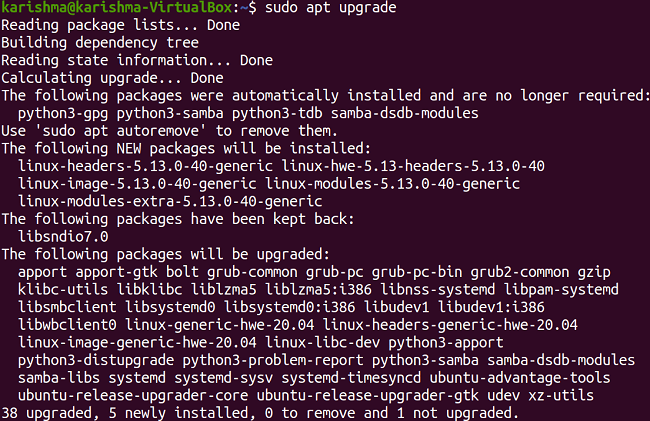
The system will successfully be updated and upgraded after using the above commands.
Enable Multiverse Repository
We need to ensure the multiverse repository is activated before going to install Steam in Ubuntu. Execute the following command in the terminal window:

Installing Steam Package
We need to run the following command for installing Steam Package from the base repository of Ubuntu:
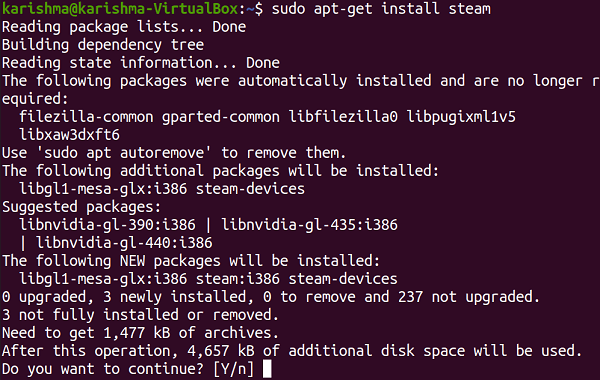
The terminal will show us two yes and no options during the installation process. We need to enter ‘y’ to proceed with the installation.
Now, the Steam Package should be successfully installed on our Ubuntu system.
Launch Steam
Launch the Steam application either from the Application Menu or the command line after installing it successfully. Execute the below command to launch the application using the command-line:
We need to go to the Application Menu and find “Steam” for launching Steam using the Application Menu. The Steam application will occur in the search outcomes.
It will download a few required updates when Steam is launched.
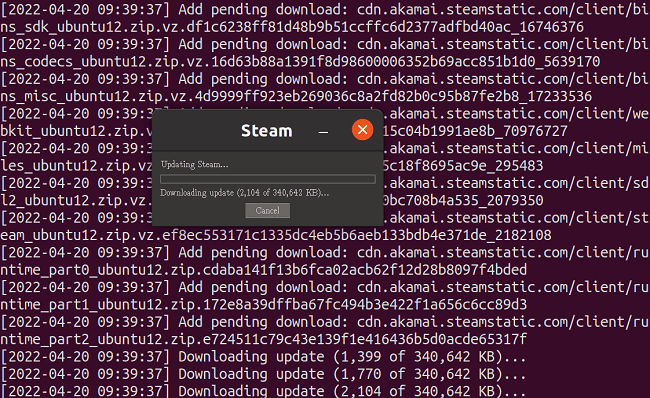
The below screen will occur when the updates are downloaded.
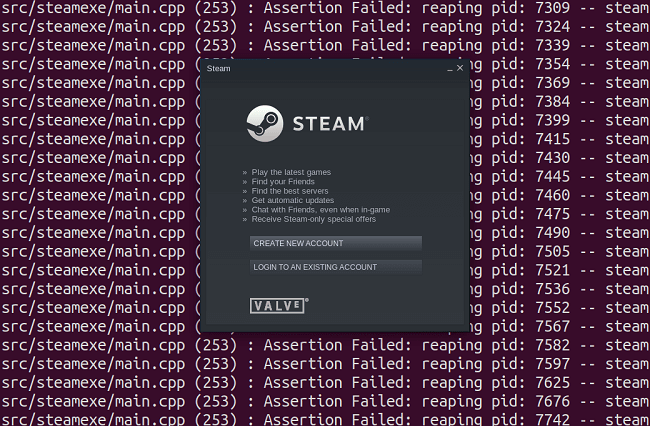
If there’s no previous account of Steam to enter to log in, choose the option, i.e., ‘Create New Account’ and fill up the correct details within the required fields.
If we already have an account of Steam, then press the option, i.e., ‘Login to An Existing Account’, and type the password and username within the required fields.
If we have any existing account, under first accessing the account with an unknown device, Steam will transfer a security code to our email address. Type the security code within the given field, and we will be ready to access Steam.
We may now find our favorite games and play them on Steam.
